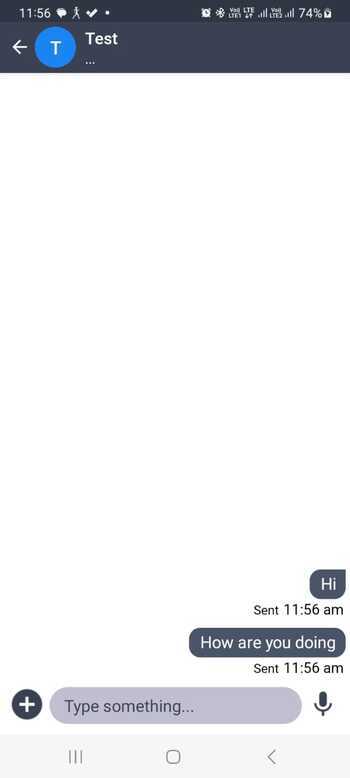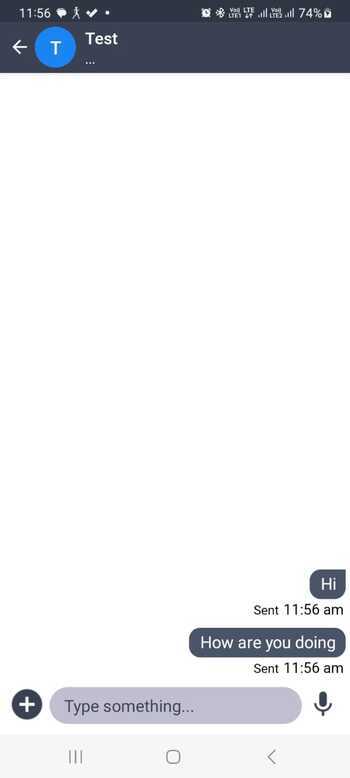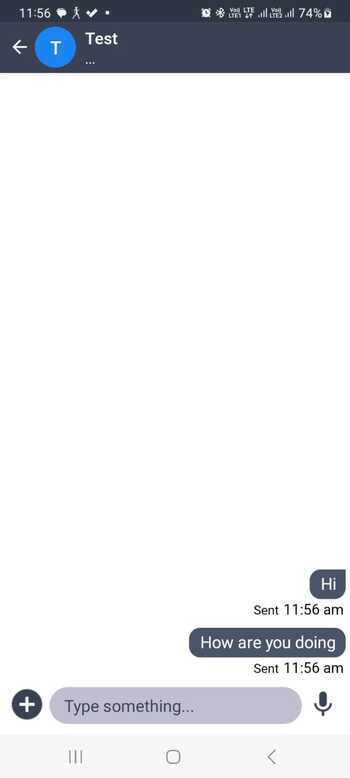
 Data Structure
Data Structure Networking
Networking RDBMS
RDBMS Operating System
Operating System Java
Java MS Excel
MS Excel iOS
iOS HTML
HTML CSS
CSS Android
Android Python
Python C Programming
C Programming C++
C++ C#
C# MongoDB
MongoDB MySQL
MySQL Javascript
Javascript PHP
PHP
- Selected Reading
- UPSC IAS Exams Notes
- Developer's Best Practices
- Questions and Answers
- Effective Resume Writing
- HR Interview Questions
- Computer Glossary
- Who is Who
How to Implement Chat Functionality in Social Media Android App?
Including a chat function in a social media Android app is essential for boosting user interaction and communication. A chat feature seamlessly allows users to send messages, share content, and stay connected with frieÂnds all within the app itself.
Implementing chat functionality in a social media Android app is crucial to enhance user engagement and communication. By integrating a chat feature, users can connect with friends, share messages, and exchange media content seamlessly within the app.
Social Media
Social media platforms are online websites allowing users to generate and exchange content, communicate with others, and participate in virtual communities. It serves as a digital arena for individuals and organizations to connect with a diverse audience. Prominently providing features like messaging services, profiles, news feed, liking/commenting tools, following other users or creators' content functions.
Social media is a platform designed to foster connections, share knowledge and information, and distribute content. With its broad potential for communication, entertainment, marketing, and community building social media's reach is unmatched.
Approaches
Various approaches can be used to add chat functionality to a social media app for Android. Below are some prevalent methods that developers often use:
Using Real-time Messaging Protocols
Using WebSocket
Using Cloud-based Messaging Services
Using API Integration
Using Real-time Messaging Protocols
Real-time messaging protocols like XMPP or MQTT enable direct communication between users by establishing communication channels. These protocols support instant messaging features, presence information, and reliable message delivery, making them suitable for implementing chat functionality in a social media app.
Algorithm
Set up a server that supports XMPP or MQTT protocols.
Establish user authentication and registration.
Create channels for users to join and send/receive messages.
Implement message routing and delivery mechanisms.
Handle presence information and online/offline status updates.
Example
import okhttp3.OkHttpClient;
import okhttp3.Request;
import okhttp3.Response;
import okhttp3.WebSocket;
import okhttp3.WebSocketListener;
import okio.ByteString;
public class ChatActivity extends AppCompatActivity {
private WebSocket webSocket;
@Override
protected void onCreate(Bundle savedInstanceState) {
super.onCreate(savedInstanceState);
setContentView(R.layout.activity_chat);
// Initialize WebSocket connection
OkHttpClient client = new OkHttpClient();
Request request = new Request.Builder().url("wss://your-chat-server-url").build();
WebSocketListener webSocketListener = new WebSocketListener() {
@Override
public void onOpen(WebSocket webSocket, Response response) {
// WebSocket connection is established
// You can send/receive messages here
// For example, you can send a welcome message to the server
webSocket.send("Hello, server!");
}
@Override
public void onMessage(WebSocket webSocket, String text) {
// Handle incoming text message
handleIncomingMessage(text);
}
@Override
public void onClosing(WebSocket webSocket, int code, String reason) {
// WebSocket connection is closing
}
@Override
public void onFailure(WebSocket webSocket, Throwable t, Response response) {
// WebSocket connection failure
}
};
webSocket = client.newWebSocket(request, webSocketListener);
}
private void handleIncomingMessage(String message) {
// Handle and display incoming message in the UI
}
private void sendMessage(String message) {
// Send message to the server
webSocket.send(message);
}
@Override
protected void onDestroy() {
super.onDestroy();
// Close the WebSocket connection when the activity is destroyed
webSocket.close(1000, "Activity destroyed");
}
}
Output

Using WebSocket
RephraseWebSocket is a protocol for communication and allows the creation of bi-directional, real-time channels over one TCP connection. This enables chats to function seamlessly between servers and clients in social media apps.
Algorithm
Implement WebSocket on the server and client sides.
Establish a connection between the client and server.
Define message formats and protocols for chat communication.
Handle incoming and outgoing messages in real-time.
Update user interfaces dynamically based on received messages.
Example
import okhttp3.OkHttpClient;
import okhttp3.Request;
import okhttp3.Response;
import okhttp3.WebSocket;
import okhttp3.WebSocketListener;
public class ChatActivity extends AppCompatActivity {
private WebSocket webSocket;
@Override
protected void onCreate(Bundle savedInstanceState) {
super.onCreate(savedInstanceState);
setContentView(R.layout.activity_chat);
// Initialize WebSocket connection
OkHttpClient client = new OkHttpClient();
Request request = new Request.Builder().url("wss://your-chat-server-url").build();
WebSocketListener webSocketListener = new WebSocketListener() {
@Override
public void onOpen(WebSocket webSocket, Response response) {
// WebSocket connection is established
// You can send/receive messages here
// For example, you can send a welcome message to the server
webSocket.send("Hello, server!");
}
@Override
public void onMessage(WebSocket webSocket, String text) {
// Handle incoming text message
handleIncomingMessage(text);
}
@Override
public void onClosing(WebSocket webSocket, int code, String reason) {
// WebSocket connection is closing
}
@Override
public void onFailure(WebSocket webSocket, Throwable t, Response response) {
// WebSocket connection failure
}
};
webSocket = client.newWebSocket(request, webSocketListener);
}
private void handleIncomingMessage(String message) {
// Handle and display incoming message in the UI
}
private void sendMessage(String message) {
// Send message to the server
webSocket.send(message);
}
@Override
protected void onDestroy() {
super.onDestroy();
// Close the WebSocket connection when the activity is destroyed
webSocket.close(1000, "Activity destroyed");
}
}
Output

Using Cloud-based Messaging Services
Cloud-based messaging services such as Firebase Cloud Messaging (FCM) or Google Cloud Pub/Sub handle the complexities of message routing, delivery, and synchronization across devices. By integrating these services, chat functionality can be implemented efficiently in the social media app without having to build and manage the underlying infrastructure.
Algorithm
Integrate with a cloud-based messaging service like FCM or Google Cloud Pub/Sub.
Configure message topics or channels for users to subscribe to.
Implement registration and subscription processes.
Send messages through the messaging service to deliver them to subscribed users.
Handle message synchronization and delivery status updates.
Example
implementation 'com.google.firebase:firebase-messaging:20.1.0'
import com.google.firebase.messaging.FirebaseMessagingService;
import com.google.firebase.messaging.RemoteMessage;
public class MyFirebaseMessagingService extends FirebaseMessagingService {
@Override
public void onMessageReceived(RemoteMessage remoteMessage) {
// Handle incoming FCM messages here
if (remoteMessage.getData().containsKey("message")) {
String message = remoteMessage.getData().get("message");
handleIncomingMessage(message);
}
}
private void handleIncomingMessage(String message) {
// Handle and display incoming message in the UI
}
}
<service
android:name=".MyFirebaseMessagingService"
android:exported="false">
<intent-filter>
<action android:name="com.google.firebase.MESSAGING_EVENT" />
</intent-filter>
</service>
import com.google.firebase.messaging.FirebaseMessaging;
public class ChatActivity extends AppCompatActivity {
private String chatTopic = "social_media_chat";
@Override
protected void onCreate(Bundle savedInstanceState) {
super.onCreate(savedInstanceState);
setContentView(R.layout.activity_chat);
// Subscribe to the chat topic
FirebaseMessaging.getInstance().subscribeToTopic(chatTopic);
}
private void sendMessage(String message) {
// Send message to the chat topic via FCM
RemoteMessage.Builder builder = new RemoteMessage.Builder(chatTopic);
builder.setData(Collections.singletonMap("message", message));
FirebaseMessaging.getInstance().send(builder.build());
}
}
Output

Conclusion
To add chat functionality to a social media Android app, developers can choose from multiple methods such as WebSocket, cloud-based messaging services and API integration. The method selection depends on factors like security, scalability, real-time updates and integration capabilities with existing platforms. Each method has its own merits enabling the developers to design interactive and engaging chat experiences within their social media apps.

